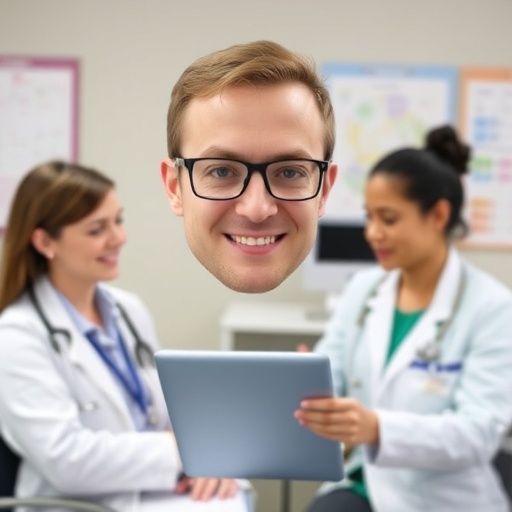In an evolving educational landscape, the integration of innovative teaching methodologies is paving the way for enhanced learning experiences in various fields. A recent study reveals the promising intersection of the One-Minute Preceptor (OMP) model and the flipped classroom approach specifically within clinical teaching in general practice. Carried out by a team of researchers led by Yueyang C., in collaboration with Li W. and Haiyan C., this research highlights the transformative potential of these combined teaching models in medical education.
The One-Minute Preceptor is widely recognized for its ability to deliver immediate, on-the-spot feedback in clinical settings. By engaging students in brief, focused interactions, it aims to elucidate critical thinking and self-assessment skills. This approach aligns well with the hectic nature of clinical environments, where time constraints often impede traditional teaching strategies. The study explores how this succinct method, when paired with the flipped classroom model, enhances student engagement and retention of vital medical knowledge.
In a flipped classroom, the traditional lecture is inverted; students are introduced to learning materials before class and utilize class time for discussions, problem-solving, and application of knowledge. This methodology encourages active participation and helps cultivate a deeper understanding of complex concepts. The integration of these two pedagogical techniques creates a dynamic learning environment, emphasizing student-centered education centered upon active learning principles.
The researchers undertook extensive data collection involving quantitative and qualitative methods to assess the implications of this combined approach for clinical teaching. Feedback from students and faculty demonstrated that the new instructional model significantly bolstered not only educational outcomes but also satisfaction levels among participants. The One-Minute Preceptor’s efficient feedback loop complements the flipped classroom’s detailed discussions, fostering a more comprehensive learning experience.
Moreover, the study emphasizes that the combination of these models encourages a culture of continuous improvement among students. Feedback provided in clinical scenarios not only aids in immediate learning but also highlights areas for further development. Consequently, students develop stronger diagnostic reasoning and a more profound clinical acumen, essential skills in the field of general practice.
One of the striking findings of the research was the increase in student engagement. The interactive nature of the flipped classroom, when enriched with real-time feedback from the OMP, transforms the learning environment into a vibrant platform for discussion. Students feel empowered to express their thoughts and ask questions, facilitating collaborative discussions that deepen understanding and foster critical thinking.
Furthermore, the importance of mentorship cannot be overstated within this framework. The role of faculty shifts to that of a facilitator rather than a prescriptive instructor. This change allows educators to cultivate a supportive atmosphere where students can thrive. By adopting the OMP model, instructors can offer personalized guidance and support, addressing individual learning needs while still promoting group dynamics within the classroom setting.
This research also delves into the challenges faced during the implementation of these combined methodologies. While the benefits are clear, educators had to navigate potential resistance to change from traditional teaching methods. Adapting to a flipped classroom requires significant preparation, and some instructors expressed concerns regarding the time investment necessary for creating effective pre-class materials. However, the long-term payoff of increased student performance and satisfaction appears to outweigh these initial hurdles.
The study advocates for ongoing professional development to support educators in transitioning to these innovative teaching methods. Training sessions and workshops could equip faculty with the skills and knowledge necessary to effectively implement and integrate the OMP and flipped classroom models in their teaching practices. As educators adjust their strategies, the potential for improvements in clinical teaching outcomes will likely continue to expand.
In a broader context, these findings contribute to the overarching narrative of educational reform in medical training. As the landscape of healthcare evolves, so too must the approaches used in educating future practitioners. Implementing adaptable and effective teaching models like the OMP and flipped classroom can significantly enhance the quality of education, leading to more competent and confident healthcare providers.
In conclusion, the collaborative research presented by Yueyang C., Li W., and Haiyan C. uncovers a potent blend of instructional strategies that promises to reshape medical education. By incorporating the One-Minute Preceptor model with the flipped classroom approach, educators can address the unique challenges and demands of clinical teaching while fostering a more responsive and engaging learning environment. As we move forward, the implications of such studies will undeniably influence educational practices, ensuring that the next generation of general practitioners is better equipped to meet the complexities of 21st-century healthcare.
The confluence of these teaching methodologies not only suggests a pathway to improved educational outcomes in medical training but also serves as a beacon for other disciplines seeking innovative solutions in the pursuit of excellence in education.
Subject of Research: The impact of the One-Minute Preceptor combined with Flipped Classroom teaching models in clinical teaching of general practice.
Article Title: The value of One-Minute Preceptor combined with Flipped Classroom teaching model in clinical teaching of general practice.
Article References: Yueyang, C., Li, W. & Haiyan, C. The value of One-Minute Preceptor combined with Flipped Classroom teaching model in clinical teaching of general practice. BMC Med Educ 25, 1196 (2025). https://doi.org/10.1186/s12909-025-07787-3
Image Credits: AI Generated
DOI:
Keywords: One-Minute Preceptor, Flipped Classroom, Clinical Teaching, Medical Education, Student Engagement.




